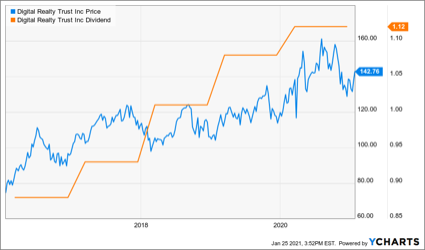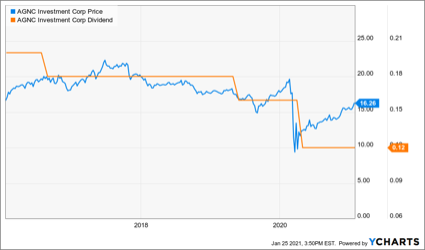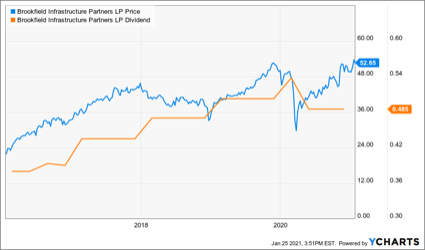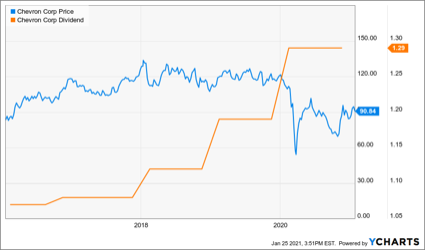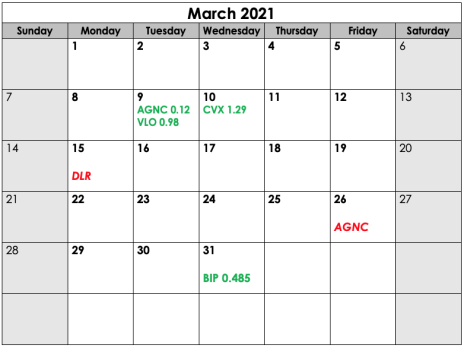The S&P 500 is making yet another new all time high. The index has risen 72% since last March and over 17% just since the beginning of October. That’s amazing performance in a short amount of time.
I’m positive on the market for the rest of this year as a full recovery along with low interest rates and massive stimulus should be very positive for stocks. But the market never goes straight up. And a selloff is overdue. It would present a buying opportunity ahead of a promising year.
While I am increasingly cautious in the near term, there are very select places where great value can still be found. And even fewer that historically move independently of the overall market.
In this issue I highlight a stock that moves to its own drummer and not with the market. It is near the low point of its range in a long-term uptrend facilitated by rapid growth in its business. The situation presents an ideal time to buy into the stock now and write calls later.
Cabot Income Advisor 121
[premium_html_toc post_id="224394"]
Prognosis: Dicey for Now and Strong for Later
The S&P 500 is making yet another new all-time high. The index has risen 72% since last March and over 17% just since the beginning of October.
That’s amazing performance in a short amount of time. While I’m positive on the market for the rest of this year, I am increasingly cautious in the near term.
There is good news. The vaccine is being distributed and promises to relieve the pandemic and lockdown restrictions as the year goes on. Many ordinarily pessimistic economists are predicting the best GDP growth in decades this year. At the same time, there will be massive amounts of stimulus floating around and record low interest rates.
Fourth-quarter earnings have been much better than expected so far. The recovery has exceeded expectations every step of the way so far, giving confidence that the expected full recovery will be quite robust. The market gets it. And stocks are flying.
But the market never goes straight up. Pullbacks and corrections are normal and healthy in even the strongest of bull markets. And we are overdue. Stock prices are getting frothy, to say the least.
Can the market continue to move higher? Sure it can. But then things will get in more precarious in the short term. And it feels like Russian roulette right now.
Things are good, but don’t be surprised if we get a selloff in the near future. That’s okay. It should present a buying opportunity ahead of what promises to be a strong year.
That said, not all stocks are expensive. There are very select places where great value can still be found. In this issue I highlight a stock that moves to its own drummer and not with the market. It is near the low point of its range in a long-term uptrend facilitated by rapid growth in its business. The situation presents an ideal time to buy into the stock now and write calls later.
What to Do Now
The income strategy has been keeping us honest in an expensive market. Several portfolio positions have been called away in recent weeks as the market values have exceeded the strike prices at expiration. Recently called stocks include AbbVie (ABBV), Altria (MO), Enterprise Product Partners (EPD), and U.S. Bancorp (USB).
The positions were sold into an expensive market and we collected an impressive income on each between dividends, call premiums and capital appreciation. Returns were the following on these recently called stocks: ABBV 21%, MO 16.1%, EPD 19.6% and USB 5.4%. These positions not only provided a great income in a short amount of time, but may provide a buying opportunity at cheaper prices during a future pullback in the market.
The remaining portfolio positions are all selling at cheap or reasonable valuations and should easily weather a short-term downturn in the market. The environment for covered calls in these value stocks is not ideal at this point, as there should be better opportunities as prices likely move higher in the future. In the meantime, the stocks continue to pay strong dividends.
Things can change fast. Opportunities can come and go quickly. Please be sure to always keep an eye out for “special alerts” about call sales or stock trades in your email.
Monthly Recap
December 23
Purchase Chevron Corp. (CVX) 85.69
December 31
ABBV Dec 31 100 call at $3.30 – Expired
AbbVie Inc. (ABBV) stock – Called
January 13
Purchase AGNC Investment Corp. (AGNC) 15.52
Purchase Brookfield Infrastructure Partners (BIP) 50.63
January 15
EPD Jan 15 20 call at $0.80 – Expired
USB Jan 15 45 call at $2.00 – Expired
MO Jan 15 40 call at $1.90 – Expired
Enterprise Product Partners (EPD) stock – Called
U.S. Bancorp (USB) stock – Called
Altria (MO) stock – Called
January 27
Purchase Digital Realty Trust (DLR)
Featured Action
Buy Digital Realty Trust (DLR)
Digital Realty is a Real Estate Investment Trust (REIT) that specializes in technology-related real estate. Specifically, it owns and operates over 270 data centers in 44 metropolitan areas across the world. It is the fifth largest REIT on the U.S. market with $3.4 in annual revenues. Its largest customers include dominant industry players including Facebook (FB), Verizon (VZ) and Oracle (ORCL).
“Data center” is one of those terms we never heard of just a few years ago. Let me explain what it is.
A data center is a facility used to house computer systems and related components. We now live in an age when large (and small) institutions operate massive technology systems that require specialized infrastructure. Companies like Facebook and AT&T (T) can’t house the core of their operations just any place.
They need a top-notch facility with the proper temperature systems for the equipment, a dependable power supply with adequate backup systems, fire suppression and various security devices. Large data centers often require as much electricity as a small town. The operational integrity of some of today’s most prominent companies depends on such facilities.
Digital Realty is one of the largest players in this new and growing type of crucial property. And these properties provide crucial services to companies involved in cloud and information technology services, communications and social networking, financial services, manufacturing, energy and healthcare.
Obviously, this kind of technology and support is a growing business. Digital also has a strong and growing presence across the world with 103 data centers in 11 countries. Since 2005, Digital has grown earnings at a compound annual growth rate of 12% and the dividend has grown 11% per year over the same period.
How has it worked out for the stock? Since the 2004 IPO, it’s returned 2,200% compared to 350% for the S&P 500 over the same period. The growth has slowed as the company has gotten bigger, but business is likely to get a big boost going forward as new technologies enabled by 5G require more infrastructure.
Why buy it now?
There are two reasons for the timing. First, it’s cheap. DLR is selling near a low point in its recent range. It’s below the 50-day moving average. Whenever that has happened in the last five years it has bounced back strongly. Of course, you might ask what kind of a loser stock is still cheap with the market near the all-time high after an epoch run-up.
That question brings me to the second reason: The stock isn’t correlated to the market. DLR has a beta of just 0.11, which means it is only one-tenth as volatile, or only moves in lockstep with the market by one-tenth. That’s a great quality in a market that is looking awfully overpriced in the near term with a pullback or correction looming.
It pays about a 3% yield at the current price. But the dividend has grown by an average of over 31% per year for the last five years.
DLR has a great growth story. It’s cheap and marches to its own drummer regardless of what the market does. The stock should trend higher in the weeks and months ahead and offer some terrific call writing opportunities.
Digital Realty Trust, Inc. (DLR)
Security type: REIT
Industry: Technology
Price: 143.43
52-week range: 105.00 - 165.49
Yield: 3.14%
Profile: Digital Realty is a REIT that owns and operates specialized data center properties throughout the world.
Positives
- The stock is near the low point of the recent range in a longer-term uptrend.
- DLR tends to move independently of the overall market.
- New technologies spawned by 5G should boost demand.
Risks
- The data center business is fiercely competitive and ever-changing.
- The market could spawn companies seen as pandemic beneficiaries as it embraces real economy companies that are still cheap.
Portfolio Updates
AGNC Investment Corp. (AGNC)
Yield 8.9%
This mortgage real estate investment trust reported earnings that surpassed expectations earlier this week. Revenues increased 23% and adjusted earnings were up 27% year-over-year. The quarter was a little worse than last quarter but things are clearly on the uptrend since the peak of the pandemic. The company mentioned that the Fed buying $1.5 trillion in MBS help boost asset values and the trend is likely to continue in the quarters ahead. The main issue is that the yield curve is steepening and longer rates are likely to rise in the months ahead as the vaccine is distributed and a full recovery gains traction. The stock price is still well below pre-pandemic levels while the environment is shaping up to be better than the pre-pandemic one. BUY
B&G Foods, Inc. (BGS)
Yield 6.3%
What the heck is going on? BGS closed Monday up over 13% on the day. It was up as much as 33% during Monday’s trading. Yet, there is no news about the company. It seems to all be about short-term trading shenanigans. There were a number of “short squeezes” that day. Groups of investors have been piling into stocks that investors are betting against by taking short positions. The buying forces the stock price higher, which in turn forces investors to cover their short position by buying the stock, resulting in even more buying.
It happened in a number of stocks besides BGS. Because BGS was up so much last year and earnings will come back down to earth when the pandemic subsides, investors were betting against it. But the stock is still cheap and earnings will likely remain at a higher level after the lockdowns. The investor tug-o-war exploded in one day. And the bulls won. We’ll see how the stock behaves from here. HOLD
Brookfield Infrastructure Partners (BIP)
Yield 3.7%
The tested and true infrastructure player is well set up going forward. The stock has been in a long, slow slog higher since the lows of last march, with relatively minor ups and downs. And it is well positioned for the months ahead as infrastructure becomes a bigger issue in the new administration, recent acquisitions will boost earnings, and its transportation assets recover. There is also a good chance that the infrastructure subsector becomes a more trendy investment as the pandemic finally fades from the news. BUY
Chevron Corp. (CVX)
Yield 5.7%
The energy sector advance that began in the beginning of the year has slowed in the last couple of weeks. That’s okay. The sector won’t go straight up. But there is certainly a lot more upside left in the months ahead as a full recovery gains traction. And CVX is the best of the best in terms of profit margins and ability to be profitable. The stock is already up 5 per share from the initial purchase price. But I prefer to wait until the stock is on another roll before writing a call. BUY
Valero Energy (VLO)
Yield 6.6%
This high leverage play on a full recovery is back up near the post-vaccine high after a brief consolidation. There are no guarantees. But if the near full recovery later this year that the market has already at least partially priced in comes to fruition, VLO will most assuredly move higher from here, and perhaps significantly so. It’s already up nicely from the initial purchase price but I’m waiting until a renewed surge in the stock price creates fat call premiums to write a call on this one. BUY
Call Trades
Sell BGS February 19 27.50 call at $2.40 or higher
Recent incredible action in the stock sort of put a crimp in this strategy. The calls were targeted at a strike price below the market in anticipation of a wallowing stock price in the near term. But recent speculation has driven the price up to a current 34.80 versus a strike price of 27.50. The current call price is well above the target of 2.40 at 8.80. It doesn’t make sense to buy back the calls. But if you own the shares and have not written these calls already it is a worthwhile trade, as recent speculation is likely to fade.
Even though the stock has not behaved as expected, we are set up to lock in a double-digit return in a short time regardless of whether the stock is called or not on February 19.
A Clarification
There may be some confusion with the current issue that I will attempt to clarify. I say that the market looks precarious and overdue for a selloff in the near term. But I highlight a stock to BUY in the issue. As well, if prices are near a short-term high, isn’t it an ideal environment in which to write covered calls? I’m just not buying any of them.
Here’s my explanation: For one, there is no guarantee that the market will sell off. It could keep going higher. Also, this portfolio just sold off four positions into this rally as they were called away. The strategy has already forced us to take profits. Plus, the stock I’m recommending buying (DLR) is unusual in that it moves independently of the market and offers a rare opportunity despite the high priced indexes.
Covered calls are more stock specific. The current positions are either trending higher or near a breakout beyond the recent highs. There is a very good chance that several of these stocks will offer higher prices and call premiums in the near future. We need to be selective and write calls in a way that will deliver a strong total return.
As I mentioned, circumstances can change fast. Please remember to always be on the lookout for “special alerts” in your email.
Income Calendar
Ex-Dividend Dates are in RED and italics. Dividend Payments Dates are in GREEN. Confirmed dates are in bold, all other dates are estimated. See the Guide to Cabot Income Advisor for an explanation of how dates are estimated.
The next Cabot Income Advisor issue will be published on February 24, 2021.
Cabot Wealth Network
Publishing independent investment advice since 1970.
President & CEO: Ed Coburn
Chairman & Chief Investment Strategist: Timothy Lutts
176 North Street, PO Box 2049, Salem, MA 01970 USA
800-326-8826 | support@cabotwealth.com | CabotWealth.com
Copyright © 2021. All rights reserved. Copying or electronic transmission of this information is a violation of copyright law. For the protection of our subscribers, copyright violations will result in immediate termination of all subscriptions without refund. No Conflicts: Cabot Wealth Network exists to serve you, our readers. We derive 100% of our revenue, or close to it, from selling subscriptions to its publications. Neither Cabot Wealth Network nor our employees are compensated in any way by the companies whose stocks we recommend or providers of associated financial services. Disclaimer: Sources of information are believed to be reliable but they are not guaranteed to be complete or error-free. Recommendations, opinions or suggestions are given with the understanding that subscribers acting on information assume all risks involved. Buy/Sell Recommendations: All recommendations are made in regular issues or email alerts or updates and posted on the private subscriber web page. Performance: The performance of this portfolio is determined using the midpoint of the high and low on the day following the recommendation. Cabot’s policy is to sell any stock that shows a loss of 20% in a bull market or 15% in a bear market from the original purchase price, calculated using the current closing price. Subscribers should apply loss limits based on their own personal purchase prices.

